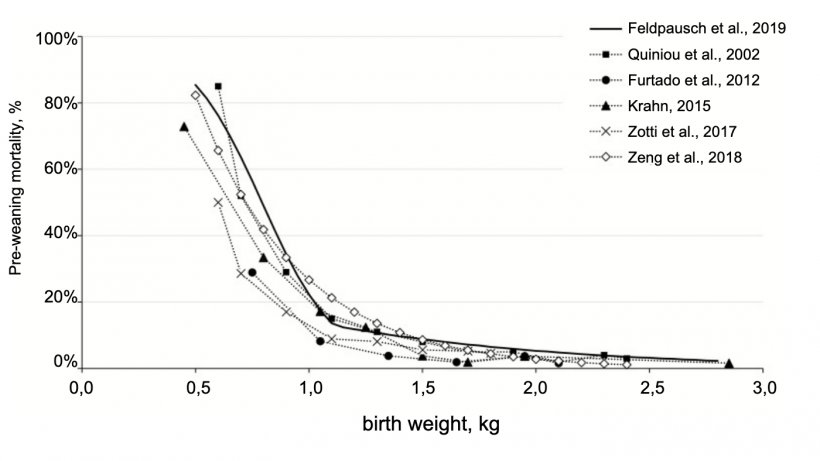Commented article
Feldpausch JA, Jourquin J, Bergstrom JR, Bargen JL, Bokenkroger CD, Davis DL, Gonzalez JM, Nelssen JL, Puls CL, Trout WE, Ritter MJ. Birth weight threshold for identifying piglets at risk for pre-weaning mortality. Translational Animal Science. 2019; 3(2): 633-640. doi: 10.1093/tas/txz076

Comment
A total of 394 litters were used; partly American data (A; 216 litters and 2,205 piglets) and partly Spanish data (S; 178 litters and 1,865 piglets). The mean litter size (Total Born) was 13.18 piglets (12.22 A and 14.34 S) and the mean pre-weaning mortality was 12.2% (9.6% A and 15.2% S). Genetics were LDXLW sow x Hampshire boar in A and LWxLD dams and Pietrain sire in S. Lactation length varied between 22 and 28 days in A and between 21 and 29 days in S. The statistical procedure used is based on logistic regression models and is detailed in the summary.
The results show that the mean threshold birth weight is 1.11 kg (1.09 for E and 1.13 for S). Overall, 15.2% of the piglets had an average birth weight equal to or less than 1.11 kg measured during the first 24 hours of life, and showed 34.4% pre-weaning mortality, while the heaviest piglets had only 8.2% mortality. Piglets born at less than 1.1 kg are almost six times more likely to die during lactation than heavier piglets. The authors show other trials conducted in recent years where the threshold weight varies between 1.0 and 1.2 kg at birth.

Figure 1. Effects of piglet birth weight on pre-weaning mortality across various studies. Feldpausch et al. (2019) values are based on the predicted pre-weaning mortality values of the current work. Values for Zeng et al. (2018) were derived from a prediction equation published by those authors. Source: Feldpausch et al., 2019.
The results suggest that the threshold birth weight is not consistent and depends, among other factors, on prolificacy and baseline mortality during lactation; the higher the prolificacy and pre-weaning mortality, the higher the threshold weight. Another aspect of interest is the percentage of piglets below the threshold weight, which tends to be higher the higher the prolificacy. On the other hand, it is known that there are three types of piglets with low birth weight: a) those with intrauterine growth restriction (IUGR) whose productive future is highly compromised and that are differentiated from the rest by their "dolphin-like" head and other morphological features, b) small piglets that in later stages will suffer an evident delay in growth and will fall behind and c) small piglets that in later stages will have satisfactory performance and can even catch up with other individuals that were heavier at birth.
In practice, depending on prolificacy and baseline mortality due to facility, sanitary, and management conditions, it may not be as important to know the threshold birth weight that is directly related to pre-weaning mortality as it is to be able to differentiate the three types of so-called "small" piglets so that after weaning they can be finished in different systems or production lines. Furthermore, in addition to prolificacy, there are at least two other management factors that are decisive in achieving a higher birth weight: 1) ensuring that gestation is completed to term; the gestation length of hyperprolific sows exceeds 115 days and knowing its true duration helps to optimize piglet birth weight and 2) achieving good embryo implantation and ensuring correct placentation during the first two months of gestation favors subsequent fetal development. It is interesting to note that incorrect use of the techniques developed during mating (e.g. insemination) and farrowing (e.g. inducing) will increase the proportion of type "a" and "b" piglets, which are the most vulnerable.
Summary of commented articleFeldpausch JA, Jourquin J, Bergstrom JR, Bargen JL, Bokenkroger CD, Davis DL, Gonzalez JM, Nelssen JL, Puls CL, Trout WE, Ritter MJ. Birth weight threshold for identifying piglets at risk for preweaning mortality. Translational Animal Science. 2019; 3(2): 633-640. doi: 10.1093/tas/txz076 Methods: Several studies have suggested there is a critical relationship between piglet birth weight and pre-weaning mortality. Thus, the objective of the current work was to identify a birth weight threshold value for pre-weaning mortality. Birth weight and survival data from two studies involving a combined total of 4,068 piglets from 394 litters on four commercial farms (three European, one U.S.) were compiled for a pooled, multistudy analysis. Overall pre-weaning mortality across the two studies was 12.2%. Key variables used in the analysis were piglet birth weight (measured within 24 h of birth) and corresponding survival outcome (dead or alive) by weaning at 3–4 wk of age. A mixed effects logistic regression model was fit to estimate the relationship between pre-weaning mortality and birth weight. A random effect of study was included to account for overall differences in mortality between the two studies. A piecewise linear predictor was selected to best represent the drastic decrease in pre-weaning mortality found as birth weight increased in the range of 0.5–1.0 kg and the less extreme change in weight above 1.0 kg. The change point of the birth weight and pre-weaning mortality model was determined by comparing model fit based on maximizing the likelihood over the interval ranging from 0.5 to 2.3 kg birth weight. Results: Results from the analysis showed a curvilinear relationship between birth weight and pre-weaning mortality where the birth weight change point value or threshold value was 1.11 kg. In the combined data set, 15.2% of pigs had birth weights ≤1.11 kg. This subpopulation of pigs had a 34.4% pre-weaning mortality rate and represented 43% of total pre-weaning mortalities. Conclusion: These findings imply interventions targeted at reducing the incidence of piglets with birth weights ≤1.11 kg have potential to improve piglet survivability. Additional research is needed to validate 1.11 kg as the birth weight threshold for increased risk of pre-weaning mortality. |






